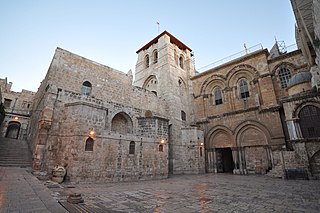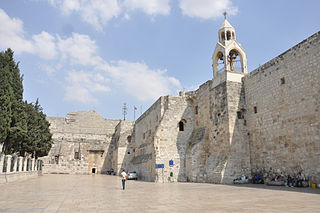
Bethlehem is a city located in the central West Bank, Palestine, about 10 km south of Jerusalem. Its population is approximately 25,000 people. It is the capital of the Bethlehem Governorate. The economy is primarily tourist-driven, peaking during the Christmas season, when Christians make pilgrimage to the Church of the Nativity. Rachel's Tomb, an important Jewish holy site, is located at the northern entrance of Bethlehem.

The Church of the Holy Sepulchre is a church in the Christian Quarter of the Old City of Jerusalem. The church contains, according to traditions dating back to at least the fourth century, the two holiest sites in Christianity: the site where Jesus was crucified, at a place known as Calvary or Golgotha, and Jesus's empty tomb, where he is said to have been buried and resurrected. The tomb is enclosed by a 19th-century shrine called the Aedicula. The Status Quo, an understanding between religious communities dating to 1757, applies to the site.

The Church of the Nativity, or Basilica of the Nativity, is a basilica located in Bethlehem in the West Bank. The grotto it contains holds a prominent religious significance to Christians of various denominations as the birthplace of Jesus. The grotto is the oldest site continuously used as a place of worship in Christianity, and the basilica is the oldest major church in the Holy Land.

The architecture of cathedrals, basilicas and abbey churches is characterised by the buildings' large scale and follows one of several branching traditions of form, function and style that all ultimately derive from the Early Christian architectural traditions established in the Constantinian period.

Aqaba is the only coastal city in Jordan and the largest and most populous city on the Gulf of Aqaba. Situated in southernmost Jordan, Aqaba is the administrative centre of the Aqaba Governorate. The city had a population of 148,398 in 2015 and a land area of 375 square kilometres (144.8 sq mi). Today, Aqaba plays a major role in the development of the Jordanian economy, through the vibrant trade and tourism sectors. The Port of Aqaba also serves other countries in the region.

Madaba is the capital city of Madaba Governorate in central Jordan, with a population of about 60,000. It is best known for its Byzantine and Umayyad mosaics, especially a large Byzantine-era mosaic map of the Holy Land. Madaba is located 30 kilometres south-west of the capital Amman.

Saint Pancras was a Roman citizen who converted to Christianity, and was beheaded for his faith at the age of fourteen, around the year 304. His name is Greek (Παγκράτιος) and means "the one that holds everything".

Maktar or Makthar, also known by other names during antiquity, is a town and archaeological site in Siliana Governorate, Tunisia.

The Holy Sepulchre is a Norman round church in Sheep Street, Northampton, England. It is a Grade I listed building. Dating from circa 1100, it was probably built by Simon de Senlis, Earl of Northampton.
The Limes Arabicus was a desert frontier of the Roman Empire, mostly in the province of Arabia Petraea. It ran northeast from the Gulf of Aqaba for about 1,500 kilometers (930 mi) at its greatest extent, reaching northern Syria and forming part of the wider Roman limes system. It had several forts and watchtowers.

The Church of the Holy Sepulchre, generally known as The Round Church, is an Anglican church in the city of Cambridge, England. It is located on the corner of Round Church Street and Bridge Street. Since 1950 the church has been designated a Grade I listed building, and is currently managed by Christian Heritage. It is one of the four medieval round churches still in use in England.

St Peter's Church is the parish church of Prestbury, Cheshire, England. It is probably the fourth church on the site. The third, the Norman Chapel, stands in the churchyard. The church is recorded in the National Heritage List for England as a designated Grade I listed building. The Norman Chapel, the lychgate and west wall, the Hearse House, and the sundial in the churchyard are listed at Grade II. It is a Church of England parish church in the diocese of Chester, the archdeaconry of Macclesfield and the deanery of Macclesfield.

St Bertoline's Church is in the village of Barthomley, Cheshire, England. The church is recorded in the National Heritage List for England as a designated Grade I listed building. It is an active Anglican parish church in the diocese of Chester, the archdeaconry of Macclesfield and the deanery of Congleton.

The Brotherhood of the Holy Sepulchre, or the Holy Community of the All-Holy Sepulchre, is an Eastern Orthodox monastic fraternity guarding the Church of the Holy Sepulchre and other Christian holy places in the Holy Land, founded in its present form during the British Mandate in Palestine (1920-1948). Headed by the Greek Orthodox Patriarch of Jerusalem, the brotherhood also administers the Greek Orthodox Church of Jerusalem, such as metropolitans, archbishops, bishops, archimandrites, hieromonks, hierodeacons, and monks.
The New Church of the Theotokos was a Byzantine church erected in Jerusalem by the Byzantine Emperor Justinian I. Like the later Nea Ekklesia in Constantinople, it is sometimes referred to in English as "The Nea".

St Andrew's Church is a redundant Church of England parish church in the village of Wroxeter, Shropshire, England. It is recorded in the National Heritage List for England as a designated Grade I listed building, and is under the care of the Churches Conservation Trust. Both the village of Wroxeter and the church are in the southwest corner of the former Roman town of Viroconium.

The ancient Megiddo church near Tel Megiddo, Israel is an archaeological site which preserves the foundations of one of the oldest church buildings ever discovered by archaeologists, dating to the 3rd century AD.

St Mary's Church is the Grade I listed Anglican parish church of West Chiltington, a village in the Horsham district of West Sussex, England. The 12th-century building, described as a "showpiece" and "the most attractive part" of the Wealden village, retains many features of historical and architectural interest. These include an exceptionally long hagioscope or squint from the south aisle into the chancel, a porch which may be Sussex's oldest, and a well preserved and extensive scheme of wall paintings. In the Sussex volume of The Buildings of England, Ian Nairn says that the appearance of the church gives "a very happy, unexpected effect, like a French village church".

Toreby Church is the parish church of Toreby on the Danish island of Lolland. It is an unusually large red-brick Romanesque building, the nave and chancel having been extended in the Gothic period with a sacristy and lateral aisle. The tower is late Romanesque. There are frescos from c. 1400 in the sacristy. The carved pulpit (1645) is the work of Jørgen Ringnis.


















